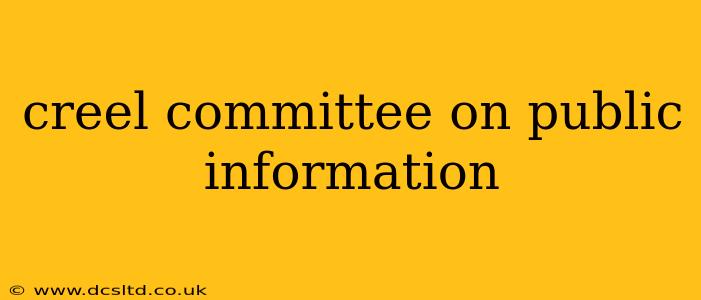The Committee on Public Information (CPI), also known as the Creel Committee, was a U.S. government agency created during World War I. Headed by journalist George Creel, its primary goal was to influence public opinion in support of the war effort. This wasn't simply about boosting morale; it was a crucial component of the war strategy itself, aiming to unify the nation behind the cause and counter German propaganda. This article delves into the history, methods, and lasting impact of this influential organization.
What was the main purpose of the Creel Committee?
The Creel Committee's main purpose was to galvanize American public support for World War I. This involved several key objectives:
- Promoting pro-war sentiment: The committee worked tirelessly to create a sense of national unity and purpose around the war, emphasizing the need for American involvement to protect democracy abroad.
- Countering German propaganda: Germany was actively engaged in propaganda efforts aimed at undermining American support for the war. The CPI countered this with its own carefully crafted messages.
- Raising funds and recruiting soldiers: The committee's campaigns played a vital role in encouraging citizens to contribute financially to the war effort and to enlist in the armed forces.
- Selling war bonds: The CPI utilized its propaganda tools to persuade Americans to invest in war bonds, a crucial source of funding for the war effort.
Essentially, the Creel Committee aimed to create a national consensus in favor of the war, shaping public perception and behavior to support the government's war aims.
How did the Creel Committee influence public opinion?
The Creel Committee employed a multi-pronged approach to influence public opinion, utilizing various forms of media and communication:
- Propaganda campaigns: The committee developed and disseminated a vast array of propaganda materials, including posters, pamphlets, films, and news articles. These materials often depicted the enemy as monstrous and portrayed American soldiers as heroic figures. The imagery was powerful and emotionally charged.
- Public speaking engagements: Creel himself and other committee members delivered speeches across the country, advocating for the war and explaining its necessity to the American public.
- Working with newspapers and magazines: The committee cultivated relationships with journalists and editors, providing them with information and shaping the narrative around the war. This ensured consistent messaging across various media outlets.
- Four-Minute Men: Thousands of volunteers, known as "Four-Minute Men," delivered short speeches in theaters and other public venues, disseminating pro-war messages to large audiences. These brief speeches were carefully crafted for maximum impact.
The effectiveness of these methods is a subject of ongoing debate, but there's no doubt that the Creel Committee significantly impacted the national discourse surrounding the war.
What were some of the criticisms of the Creel Committee?
Despite its successes, the Creel Committee faced criticism:
- Propaganda and censorship: Critics argued that the committee engaged in excessive propaganda and censorship, suppressing dissenting voices and manipulating public opinion. The line between informing and manipulating was often blurred.
- Ethnocentrism and xenophobia: Some of the committee's propaganda materials fueled anti-German sentiment, leading to discrimination and prejudice against German-Americans. This xenophobia had lasting consequences.
- Lack of transparency: The committee's operations lacked transparency, raising concerns about its accountability and potential for abuse of power.
These criticisms highlight the ethical dilemmas inherent in government attempts to shape public opinion, even in times of war.
Was the Creel Committee effective?
The Creel Committee's effectiveness is a complex issue. While it undeniably influenced public opinion and helped mobilize support for the war, the extent of its impact remains a subject of scholarly debate. Its success can be partly attributed to the already existing pro-war sentiment amongst a significant portion of the American population, alongside effective communication strategies. However, the use of propaganda and potential for manipulation raise questions about the ethical implications of such large-scale influence campaigns. Ultimately, evaluating its effectiveness requires careful consideration of both its successes and its flaws.
What is the legacy of the Creel Committee?
The Creel Committee's legacy is multifaceted. It demonstrated the power of government-sponsored propaganda to shape public opinion and demonstrated the importance of public relations in times of crisis. However, its legacy also includes warnings about the potential for abuse of power and the importance of critical media literacy. The lessons learned from the Creel Committee continue to be relevant in today's media-saturated world, where the influence of government and private actors on public opinion remains a significant concern. The committee's legacy serves as a cautionary tale and a case study in the complex interplay between government, propaganda, and public perception.
